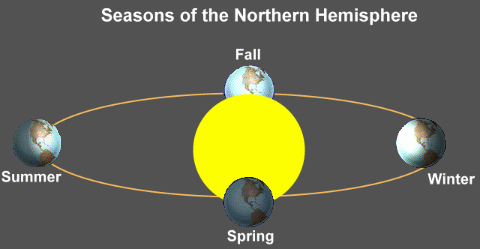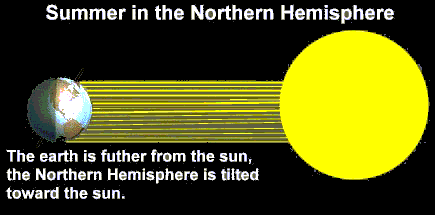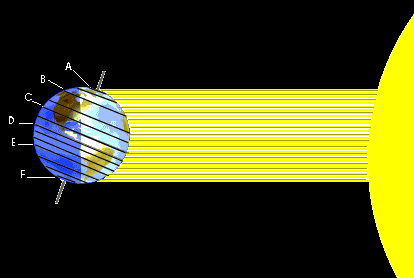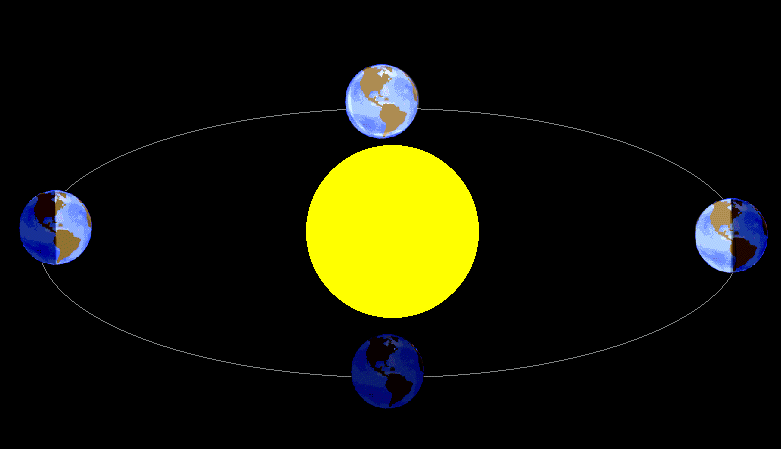
People long ago did not understand why the weather would get cold at certain times, and the leaves would fall off the trees. So they made up stories to help explain what they did not understand. The Greeks thought that the seasons changed because Demeter, the goddess of the harvest, would mourn the loss of her daughter to Hades, the god of the underworld. She had to spend part of every year with him, and that is when her mother was overcome with grief. She allowed the fields to grow cold and lifeless.
Well, that is not what really happens! Read on to find out why the seasons change.
The Earth orbits the Sun. The Earth's orbit is an ellipse, a slightly flattened circle.

Because the orbit is an ellipse, the Earth gets closer to the Sun when it passes through the narrower part of the circle in its 365 day revolution. But look at the seasons that the northern hemisphere is having when the Earth is closest to the Sun. What season did you expect it to be?
How close the Earth is to the Sun really makes very little difference. The distance may look like it is a lot in the picture, but compared to distances in space, it is small
Something else must be going on!!
Something else is going on! It is the tilt of the Earth's axis that causes the seasons to change. If the axis were not tilted, different locations would have different seasons, but the season would not change.
It all has to do with the angle the rays of the Sun hit the Earth, and that depends on the tilt of the axis.
In June, the Northern Hemisphere points most toward the Sun in. Because the Earth is leaning toward the Sun, it receives direct rays of sunlight and is warmer.

In December, the northern hemisphere points most away from the Sun. Because the northern half is leaning away from the sun, it receives the least amount of direct rays of sunlight and is cooler.
Study the diagram below. Then answer the questions.
1. What season is it in the northern hemisphere?
2. Find approximately where we live. Is night starting, or is it the beginning of the day? (Remember, the Earth rotates from west to east.)
3. Which part of the Earth is getting hit directly with sunlight, the northern hemisphere or the southern hemisphere?
4. Follow along the labeled latitude lines. Watch how they pass through daylight and through night. For each line, write the number from 1 to 5 that tells whether a person living on that line would spend...

1. Equal time in day and night
2. More night than day
3. More day than night
4. Only darkness.
5. Only daylight.
|
line A = |
line B = | line C = |
| line D = | line E = |
line F = |
There's more! In the summer, the angle of the Sun is higher, and therefore the days are longer. This gives the Sun more time to heat the Earth, so it gets hotter. In the winter, the angle of the Sun is lower, and the days are short, giving the Sun less time to heat the Earth.
Try thinking about it this way. When the Sun is higher in the sky, the light is falling straight on you, and so more light (and more heat) hit each square centimeter of the ground. When the Sun is low, the light gets more spread out over the surface of the Earth, and less heat (per square centimeter) can be absorbed. Since the Earth's axis is tilted, the Sun is higher when you are on the part of the Earth where the axis points towards the Sun, and lower on the part of the Earth where the axis points away from the Sun.
Because the Earth's orbit around the Sun does not change, we can predict the seasons; The summer solstice is the first day of summer and the longest day of the year. Summer solstice occurs in the Northern Hemisphere when the North Pole is leaning more directly toward the sun than it does on any other day of the year. During the summer season, the Northern Hemisphere is warmed by more direct sunlight and days are long and hot.
The winter solstice, by contrast, is the first day of winter and the shortest day of the year. As you might have guessed, the winter solstice in the Northern Hemisphere occurs when the North Pole is leaning away from the sun. When the North Pole is pointing away from the sun, the Northern Hemisphere receives only indirect sunlight; that is why winter is so much colder than summer.
Which would be the favorite day for a vampire in the northern hemisphere, the summer solstice or the winter solstice?
It is a hot day in August. You watch your friend pack his snow skis for his vacation. Where, in general, might he be going on this vacation?
Equinoxes occur during when the Sun shines directly on the equator. These days are marked by equal periods of light and darkness. The autumnal equinox is the first day of autumn and occurs when the North Pole begins to lean away from the Sun; the vernal equinox is the first day of spring and occurs when the North Pole begins to lean toward the Sun again.
What is the autumnal equinox?
Is there a clue in the word equinox that will help you remember what it means?
And, if all of that wasn't enough, here is one more thing to think about! The days are longer in summer and shorter in winter the further you move from the equator. It's generally dark on a summer night in Florida by 8:30 p.m., but in Vermont, there will still be some light at 10:00 p.m. The situation is reversed in the winter, where the Sun will go down in Vermont by 3:45 while it remains light in Florida until 5:15. Northern Alaska is called the "Land of the Midnight Sun" because it never gets dark during their summer months. That part of the Earth is facing the Sun all day and all night. Antarctica never sees daylight during those months. The opposite is true in December and January when northern Alaska never sees the Sun and Antarctica sees the "Midnight Sun".
What do you think about Santa making his toys in the winter season at the North Pole?
Show how much you have learned. Copy and paste the diagram below into paint. Label as much as you can to show what you have learned, without creating a confusing mess!
